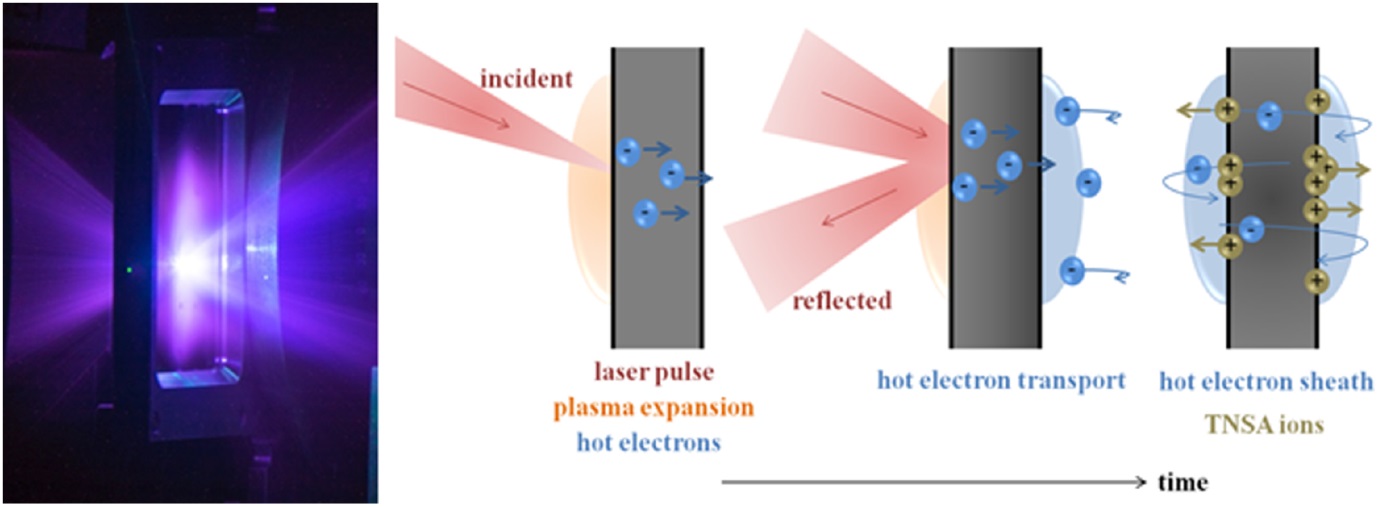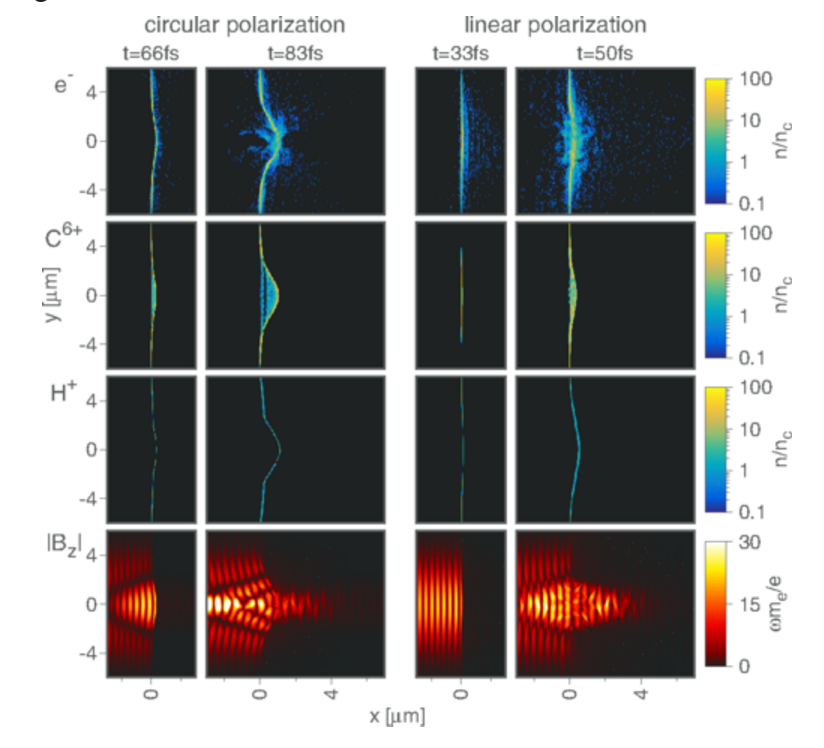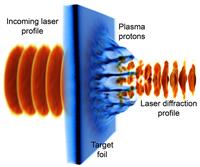The study of laser-accelerated proton beams is an exciting area of research at present. The potential applications span from their use as a particle probe to areas of healthcare and industry. Early experiments with ion acceleration driven by ultra-intense lasers demonstrated that low emittance, short pulse duration (~ 1 picosecond), sources of proton beams could be generated with energies of 10s of MeV
[1]. It was quickly recognised that such a source could have many unique applications.
 |
| Diagram illustrating conventional sheath acceleration of ions, driven by high energy electrons that are accelerated by an ultra-intense laser-matter interaction (click to expand) |
The Bragg peak energy deposition profile associated with ion beam stopping in matter, together with high peak currents, means that laser-driven ion beams can rapidly heat a localised area of material, producing novel warm dense matter (WDM) states relevant to astrophysical studies
[2]. In addition using ions to isochorically heat mater could underpin one approach to the fast ignition method of inertial confinement fusion (ICF)
[3]. Laser-driven ion beams are also a powerful tool for probing rapidly evolving plasmas in the laboratory. The high spatial quality and short temporal duration permit high resolution measurements of electric and magnetic fields
[4] through observations of proton beam deflection.
There is a high level of interest in utilising ion beams to deliver radiotherapy treatment rather than conventional X-rays. Currently this can only be achieved using large scale, costly cyclotron or synchrotron facilities within the hospital. Using a laser-driven ion source could mark a radical new approach, reducing ion beam transport and delivery costs
[5].
The Vulcan and Gemini laser systems based at the CLF are central to the development of laser-driven ion acceleration, from understanding the core science to performing proof of principle experiments in a number of key application areas. Over recent years the community has continued to focus on a number of important areas:
- Exploring novel acceleration mechanisms that could deliver > 200 MeV proton energies
- Laser-driven ions to diagnose plasma dynamics
- Applications of laser-driven ions
- Conversion of laser-driven ions into bright neutron sources
Recent CLF Results
Near-100 MeV protons via a laser-driven transparency-enhanced hybrid acceleration scheme - A. Higginson et al.
Nat. Comms.9 (2018)
A recent experiment led by Paul McKenna
and his team from the University of Strathclyde, in collaboration with
Queen's University Belfast, Shanghai Jiao Tong University and
researchers from the Central Laser Facility, used the CLF's own Vulcan Petawatt
laser to create proton energies close to 100 MeV.
Enhanced Laser-Driven Ion Acceleration by Superponderomotive Electrons Generated from Near-Critical-Density Plasma
JH Bin et al.
Phys. Rev. Lett.120 74801 (2018)
Polarization Dependence of Bulk Ion Acceleration from Ultrathin Foils Irradiated by High-Intensity Ultrashort Laser Pulses - C. Scullion et al.
Phys. Rev. Lett.119 (2017)

PIC simulations of ion acceleration using both linear and circular polarisation laser pulses
Credit: Physical Review Letters | A recent experiment at the CLF has explored the Light Sail regime of ion acceleration using circularly polarised light on the Gemini laser. Ions accelerated from ultrathin (10-100nm) carbon foils showed a strong dependence on laser polarisation, with energies of up to 30 MeV / nucleon with circular polarisation.
|
Towards optical polarization control of laser-driven proton acceleration in foils undergoing relativistic transparency (link opens in a new window) - B Gonzalez-Izquierdo et al.
Nat. Comms. 7 12891 (2016)

Schematic of a beam of intense light passing through a 'relativistically transparent' aperture in a thin foil target.
Credit: University of Strathclyde | A targeted way to manipulate beams of protons accelerated using ultrashort and ultra-intense laser pulses has been demonstrated by a team of researchers led by the University of Strathclyde and performed using the Gemini laser at the Central Laser Facility.
|
Experiment and simulation of novel liquid crystal plasma mirrors for high contrast, intense laser pulses (link opens in a new window)P L Poole et al.
Sci. Reports 6 32041 (2016)
Ion Acceleration Using Relativistic Pulse Shaping in Near-Critical-Density Plasmas (link opens in a new window)
JH Bin et al.
Phys. Rev. Lett.115 064801 (2015)
Selective deuterium ion acceleration using the Vulcan petawatt laser (link opens in a new window)AG Krygier et al.
Phys. Plasmas 22 053102 (2015)
Proton acceleration enhanced by a plasma jet in expanding foils undergoing relativistic transparency (link opens in a new window)H W Powell et al.
New J. Phys.17 103033 (2015)
High efficiency proton beam generation through target thickness control in femtosecond laser-plasma interactions (link opens in a new window)J S Green et al.
Appl. Phys. Lett.104 064801 (2014)
Modelling the effect of laser focal spot size on sheath-accelerated protons in intense laser-foil interactions (link opens in a new window)C M Brenner et al.
Plasma Phys. Control. Fusion
56 084003 (2014)
Azimuthal asymmetry in collective electron dynamics in relativistically transparent laser–foil interactions (link opens in a new window)R J Gray et al.
New J. Phys.16 093027 (2014)
High energy conversion efficiency in laser-proton acceleration by controlling laser-energy deposition onto thin foil targets (link opens in a new window)C M Brenner et al.
Appl. Phys. Lett.104 081123 (2014)
Other Resources
References
[1] Snavely et al. PRL 85 2945 (2000), Clark et al. PRL 84 670 (2000)
[2] Patel et al. PRL 91 125004 (2003)
[3] Roth et al. PRL 86 p436-439 (2001)
[4] Borghesi et al. Phys. Plasmas 9 p2214-2220 (2002), Cowan PRL 92 204801 (2004)
[5] Bulanov et al. Phys. Rev. Lett. A 299 p240-247 (2002)
